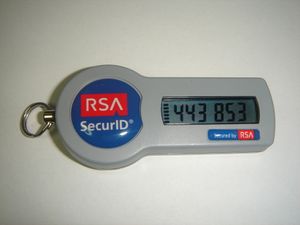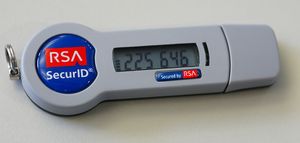سكيورأيدي
سكيورأيدي SecurID، ويعرف باسم أرإسإيه سكيورأيدي RSA SecurID، هي آلية طورها أرإسإيه، فرع الأمن في إيإمإس for performing two-factor authentication for a user to a network resource.
نظرة عامة
The RSA SecurID authentication mechanism consists of a "token"—a piece of hardware (e.g. a token or USB) or software (e.g. a "soft token" for a computer, PDA or cell phone)—assigned to a computer user that generates an authentication code at fixed intervals (usually 30 or 60 seconds) using a built-in clock and the card's factory-encoded random key (known as the "seed" and often provided as an ASCII file). The seed is different for each token, and is loaded into the corresponding RSA SecurID server (RSA Authentication Manager, formerly ACE/Server) as the tokens are purchased. The seed is typically 128 bits long. Some RSA SecurID deployments may use varied second rotations, such as 30-second increments.[بحاجة لمصدر]
The token hardware is designed to be tamper-resistant to deter reverse engineering. Despite this, public code has been developed by the security community allowing a user to emulate RSA SecurID in software, but only if they have access to a current RSA SecurID code, and the original RSA SecurID seed file introduced to the server.[1] In the RSA SecurID authentication scheme, the seed record is the secret key used to generate one-time passwords. "Soft tokens" are merely commercial software implementations of the same algorithms implemented in the tamper-resistant hardware, only the soft tokens require the seed record to be distributed to clients so that the seed record may be used as input in the one-time password generation. Newer versions also feature a USB connector, which allows the token to be used as a smart card-like device for securely storing certificates.[2]
A user authenticating to a network resource—say, a dial-in server or a firewall—needs to enter both a personal identification number and the number being displayed at that moment on their RSA SecurID token. Some systems using RSA SecurID disregard PIN implementation altogether, and rely on password/RSA SecurID code combinations. The server, which also has a real-time clock and a database of valid cards with the associated seed records, computes what number the token is supposed to be showing at that moment in time, checks it against what the user entered, and makes the decision to allow or deny access.[بحاجة لمصدر]
On systems implementing PINs, a "duress PIN" may be used—an alternate code which creates a security event log showing that a user was forced to enter their PIN, while still providing transparent authentication.[بحاجة لمصدر]
While the RSA SecurID system adds a strong layer of security to a network, difficulty can occur if the authentication server's clock becomes out of sync with the clock built in to the authentication tokens. However, typically the RSA Authentication Manager automatically corrects for this without affecting the user. It is also possible to resync a token manually in the RSA Authentication Manager. Providing authentication tokens to everyone who might need to access a resource can be expensive (about $15 per year + licencing costs), particularly since tokens are programmed to "expire" at a fixed time, usually three years, requiring purchase of a new token.[بحاجة لمصدر]
RSA SecurID currently commands over 70% of the two-factor authentication market (source: IDC) and 25 million devices have been produced to date. A number of competitors, such as VASCO, make similar security tokens, mostly based on the open OATH HOTP standard. A study on OTP published by Gartner in 2010 mentions OATH and SecurID as the only competitors.[3]
RSA Security has pushed forth an initiative called "Ubiquitous Authentication", partnering with device manufacturers such as IronKey, SanDisk, Motorola, Freescale Semiconductor, Redcannon, Broadcom and BlackBerry to embed the SecurID software into everyday devices such as USB flash drives and cell phones, to reduce cost and the number of objects that the user must carry.[4]
Other network authentication systems, such as OPIE and S/Key (sometimes more generally known as OTP, as S/Key is a trademark of Telcordia Technologies, formerly Bellcore) attempt to provide the "something you have" level of authentication without requiring a hardware token.[بحاجة لمصدر]
نقاط الضعف النظرية
The most simple practical vulnerability with any password containers is just losing the special key device or the activated smart phone with the integrated key function. Such vulnerability cannot be healed with any single token container device within the pre-set time span of activation. All further consideration presumes performant loss prevention, e.g. by additional electronic leash or body sensor and alarm.
While RSA SecurID tokens offer a level of protection against password replay attacks, they might fail to provide adequate protection against man in the middle type attacks. In the attack model where an attacker is able to manipulate the authentication data flow between a user and the server, the attacker will be able to then forward this authentication information on to the server themselves, effectively masquerading as the given user. If the attacker manages to block the authorised user from authenticating to the server until the next token code will be valid, he will be able to log in to the server. RSA SecurID does not prevent Man in the Browser (MitB) based attacks.[5]
SecurID authentication server tries to prevent password sniffing and simultaneous login by declining both authentication requests, if two valid credentials are presented within a given time frame. See an unverified John G. Brainard post for more information. If the attacker removes from the user the ability to authenticate however, the SecurID server will assume that it is the user who is actually authenticating and hence will allow the authentication through. Under this attack model, the system security can be improved using encryption/authentication mechanisms such as SSL.
Although soft tokens may be more convenient, critics indicate that the tamper-resistant property of hard tokens is unmatched in soft token implementations, which could potentially allow seed record secret keys to be duplicated and user impersonation to occur.
Hard tokens on the other hand can be physically stolen (or acquired via social engineering) from end users. The small form factor makes hard token theft much more viable than laptop/desktop scanning. A user will typically wait more than one day before reporting the device as missing [بحاجة لمصدر], giving the attacker plenty of time to breach the protected system.
March 2011 system compromise
On March 17, 2011, RSA announced that they had been victims of "an extremely sophisticated cyber attack".[6] Concerns were raised specifically in reference to the SecurID system, saying that "this information could potentially be used to reduce the effectiveness of a current two-factor authentication implementation." However, their formal SEC 8K submission[7] indicates that they don't believe the breach will have a "material impact on its financial results." The extent of the compromise and the associated risk to customers will not be known until further details have been released.
There are some hints that the breach involved the theft of RSA's database mapping token serial numbers to the secret token "seeds" that were injected to make each one unique.[8] Reports of RSA executives telling customers to "ensure that they protect the serial numbers on their tokens"[9] lend credibility to this hypothesis.
In a March 21 email to customers, RSA essentially admitted that the information stolen from their internal network would allow an attacker to compromise a SecurID-protected system without having physical possession of the token:
- "7. Have my SecurID token records been taken?
- For the security of our customers, we are not releasing any additional information about what was taken. It is more important to understand all the critical components of the RSA SecurID solution.
- To compromise any RSA SecurID deployment, the attacker needs to possess multiple pieces of information about the token, the customer, the individual users and their PINs. Some of this information is never held by RSA and is controlled only by the customer. In order to mount a successful attack, someone would need to have possession of all this information."
Barring a fatal weakness in the cryptographic implementation of the tokencode generation algorithm (which is unlikely, since it involves the simple and direct application of the extensively scrutinized AES-128 block cipher), the only circumstance under which an attacker could mount a successful attack having only information about (but not physical possession of) the token, is if the token seed records had been leaked.
تسوية لوكهيد مارتن، مايو 2011
في مايو 2011، تم استخدام هذه المعلومات لاختراق أنظمة لوكهيد مارتن.[10][11] ومع ذلك إدعت لوكهيد مارتن أنه نظرا "للاحتياطيات الأمنية" التي يتخذها فريق أمن المعلومات في الشركة، وأكدت عدم تعرض أي من أنظمتها أو بيانات العملاء أو الموظفين للخطر بعد هذا الهجوم القوي.[12] وأعلنت وزارة الأمن الداخلي أنها ووزارة الدفاع، عرضتا المساعدة في تحديد حجم الحادث الإلكتروني الذي أثر على لوكهيد مارتن.[13]
وصلات خارجية
تفاصيل فنية
- Sample SecurID Token Emulator with token Secret Import I.C.Wiener, Bugtraq post.
- Apparent Weaknesses in the Security Dynamics Client/Server Protocol Adam Shostack, 1996.
- Usenet thread discussing new SecurID details Vin McLellan, et al., comp.security.misc.
- Unofficial SecurID information and some reverse-engineering attempts Yahoo Groups securid-users.
- Inside a hardware token
- Analysis of possible risks from 2011 compromise
- Understanding the Impact of the RSA SecurID Breach (2011)
هجمات أعلن عنها بواسطة سكيور أي دي
- Cryptanalysis of the Alleged SecurID Hash Function (PDF) Alex Biryukov, Joseph Lano, and Bart Preneel.
- Improved Cryptanalysis of SecurID (PDF) Scott Contini and Yiqun Lisa Yin.
- Fast Software-Based Attacks on SecurID (PDF) Scott Contini and Yiqun Lisa Yin.
Versatile Authentication Server
المصادر
- ^ Sample SecurID Token Emulator with Token Secret Import
- ^ RSA SecurID SID800 Hardware Authenticator
- ^ Diodati, Mark (2010). "Road Map: Replacing Passwords with OTP Authentication". Burton Group.
Gartner's expectation is that the hardware OTP form factor will continue to enjoy modest growth while smartphone OTPs will grow and become the default hardware platform over time. ... If the organization does not need the extensive platform support, then OATH-based technology is likely a more cost-effective choice.
- ^ http://www.encyclopedia.com/doc/1G1-142107014.html
- ^ "Testing Multiple Factors Authentication (OWASP-AT-009)".
- ^ "Open Letter to RSA Customers".
- ^ "EMC / RSA 8K filing".
- ^ "RSA won't talk? Assume SecurID is broken".
- ^ "Did hackers nab RSA SecurID's secret sauce?".
- ^ Leyden, John. "Lockheed Martin suspends remote access after network 'intrusion'." The Register, 27 May 2011.
- ^ "Lockheed Network Reportedly Suffers Security Breach." Fox News quoting WSJ, 28 May 2011.
- ^ "Lockheed Martin confirms attack on its IT network." AFP, 28 May 2011.
- ^ Wolf, Jim. "Lockheed Martin hit by cyber incident, U.S. says." Reuters, 28 May 2011.


